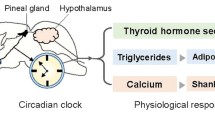Summary
-
1.
Chickens kept in constant light, as opposed to constant darkness, display a twofold increase in the activity of pineal hydroxyindole-O-methyltransferase (HIOMT), the last acting enzyme in the melatonin pathway.
-
2.
Using an immunological approach, we presently show that this regulation of HIOMT activity reflects changes in the concentration of a single molecular form of the enzyme protein (a 38 kDa polypeptide). Immunohistofluorescence indicates that these concentration changes concurrently affect modified photoreceptors and pinealocyte-like cells in the chicken pineal organ.
-
3.
Together, the present data support the hypothesis that environmental lighting might regulate the expression of the HIOMT gene.
Similar content being viewed by others
References
Axelrod, J., and Weissbach, H. (1960). Enzymatic O-methylation of N-acetylserotonin to melatonin.Science 1311312.
Axelrod, J., and Wurtman, J. (1964). Melatonin synthesis in the hen pineal gland and its control by light.Nature 2011134.
Barfuss, D. W., and Ellis, L. C. (1971). Seasonal cycles in melatonin synthesis by the pineal gland as related to testicular function in the house sparrow (Passer domesticus).Gen. Comp. Endocrinol. 17183–193.
Bernard, M., Voisin, P., Guerlotté, J., and Collin, J. P. (1991). Molecular and cellular aspects of hydroxyindole-O-methyltransferase expression in the developing chick pineal gland.Dev. Brain Res. 5975–81.
Bradford, M. M. (1976). A rapid and sensitive method for the quantification of microgram quantities of protein utilizing the principle of protein-dye binding.Anal. Biochem. 72248–254.
Collin, J. P., Voisin, P., Falcon, J., Faure, J. P., Brisson, P., and Defaye, J. P. (1989). Pineal transducers in the course of evolution: Molecular organization, rhythmic metabolic activity and role.Arch. Histol. Cytol. 52 (Suppl):441–449.
Guerlotté, J., Voisin, P., Brisson, P., Faure, J. P., and Collin, J. P. (1988). Synthesis of melatonin by the pineal modified photoreceptors of birds: Immunocytochemical localisation of hydroxyindole-O-methyltransferase.Biol. Cell. 6493–96.
Jackson, R. L., and Lovenberg, W. (1971). Isolation and characterization of multiple forms of hydroxyindole-O-methyltransferase.J. Biol. Chem. 2464280–4285.
Klein, D. C. (1979). Circadian rhythms in the pineal gland. InEndocrine Rhythms; Comprehensive Endocrinology (D. Krieger, Ed.), Raven Press, New York, pp. 203–223.
Klein, D. C., and Weller, J. L. (1970). Indole metabolism in the pineal gland: A circadian rhythm in N-acetyltransferase.Science 1691093–1095.
Laemmli, U. K. (1970). Cleavage of structural proteins during the assembly of the head of bacteriophage T4.Nature (London) 227680–685.
Lauber, J. K., Boyd, J. E., and Axelrod, J. (1968). Enzymatic synthesis of melatonin in avian pineal body: Extraretinal response to light.Science 161489–490.
Ohshima, K., and Matsuo, S. (1988). Cytodifferentiation of the chick pineal gland, with special reference to the photosensory and secretory elements.J. Pineal. Res. 5397–410.
Quay, W. B. (1974).Pineal Chemistry in Cellular and Physiological Mechanisms, C. C. Thomas, Springfield, Ill.
Reiter, R. J. (1980). The pineal gland and its hormones in the control of reproduction in mammals.Endocrine Rev. 1109–131.
Reiter, R. J. (1981).The Pineal Gland. Vols I, II, and III, CRC Press, Boca Raton, Fla.
Sugden, D., and Klein, D. C. (1983a), Adrenergic stimulation of rat pineal hydroxyindole-O-methyltransferase.Brain Res. 265348–351.
Sugden, D., and Klein, D. C. (1983b).β-Adrenergic receptor control of rat pineal hydroxyindole-O-methyltransferase.Endocrinology 113348–353.
Vanecek, J. (1988). Melatonin binding sites.J. Neurochem. 511436–1440.
Voisin, P., Namboodiri, M. A. A., and Klein, D. C. (1984). Arylamine N-acetyltransferase and arylalkylamine N-acetyltransferase in the mammalian pineal gland.J. Biol. Chem. 25910913–10918.
Voisin, P., Guerlotté, J., and Collin, J. P. (1988). An antiserum against chicken pineal hydroxyindole-O-methyltransferase reacts with the enzyme from pineal gland and retina and labels pineal modified photoreceptors.Mol. Brain. Res. 453–61.
Wainwright, S. D. (1974). Course of increase in hydroxyindole-O-methyltransferase activity in the pineal gland of the chick embryo and young chick.J. Neurochem. 22193–196.
Wurtman, R. J., Axelrod, J., and Fisher, J. E. (1964). Melatonin synthesis in the pineal gland: Effect of light mediated by the sympathetic nervous system.Science 1431329–1330.
Yang, H. Y. T., and Neff, N. H. (1976). Hydroxyindole-O-methyltransferase: An immunochemical study of the neuronal regulation of the pineal enzyme.Mol. Pharmacol. 12433–439.
Zimmerman, N. H., and Menaker, M. (1979). The pineal: A pacemaker within the circadian system of the house sparrow.Proc. Natl. Acad. Sci. USA 76999–1003.
Author information
Authors and Affiliations
Rights and permissions
About this article
Cite this article
Guerlotté, J., Voisin, P., Bernard, M. et al. Long-term effects of constant light or darkness on chicken pineal hydroxyindole-O-methyltransferase expression: biochemical and cellular aspects. Cell Mol Neurobiol 12, 177–184 (1992). https://doi.org/10.1007/BF00713371
Received:
Accepted:
Issue Date:
DOI: https://doi.org/10.1007/BF00713371




